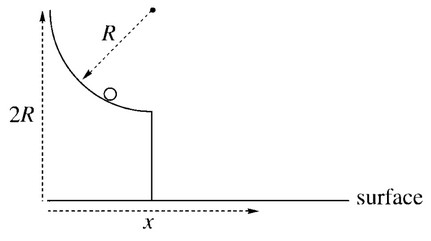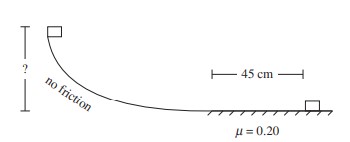Question

In the figure above, a small object slides down a frictionless quarter-circular slide of radius R. If the object starts from rest at a height equal to 2R above a horizontal surface, find its horizontal
displacement, x, at the moment it strikes the surface.
(A) 2R
(B) \(\frac{5}{2}R\)
(C) 3R
(D) \(\frac{7}{2}R\)
(E) 4R
Answer/Explanation
Ans: C
The object’s initial velocity from the slide is horizontal, so \(v_{oy}=0\), which implies that \(\Delta = -\frac{1}{2}gt^2\). Since \(\Delta y = -R\),
\(-R = -\frac{1}{2} gt^2 \Rightarrow t = \sqrt{\frac{2R}{g}}\)
The (horizontal) speed with which the object leaves the slide is found from the conservation of energy: \(mgR = \frac{1}{2} mv^2\), which gives \(v=\sqrt{2gR}\). Therefore,
\(\Delta x = v_{ox} t = \sqrt{2g R} . \sqrt{\frac{2R}{g}} = 2R\)
Since the object travels a horizontal distance of 2R. from the
end of the slide, the total horizontal distance from the
Question

A block is released from rest at the top of a ramp on which friction is negligible. At the bottom of the ramp, the block encounters a rough, level surface on which the coefficient of kinetic friction with the block is 0.20. The block slides to rest after traveling 45 cm on the rough surface, as shown in the diagram. From what height vertically above the rough surface was the block released?
(A) 9 cm
(B) 22.5 cm
(C) The answer cannot be determined without knowing the mass of the block.
(D) 225 cm
(E) 90 cm
Answer/Explanation
Ans:
A—The energy conversion here is gravitational potential energy (mgh) to work done by friction (equal to friction force times distance, where friction force is mu times the normal force): mgh = \(\mu \)mgd . Solving, h = \(\mu \)d. Here \(\mu \) is 0.20 and d = 0.45 m.
Questions (a)-(b)

In the diagram above, a block of mass M is initially at rest on a horizontal surface at the base of an inclined plane. The surface and plane have negligible friction. The block is struck by a projectile of mass m traveling with a horizontal velocity \(v_i\) . The projectile becomes embedded in the block, and they move together to the right with speed \(v_ f\) .
Question(a)
Which of the following is a correct expression for\( v _f\) ?
(A)\(\sqrt{gh}\)
(B)\(\sqrt{v^2_{i}}\)
(C)\(\frac{m}{(m+M)}v_{i}\)
(D)\(\frac{m}{M}v_{i}\)
(E)\(\frac{M}{m}v_{i}\)
Answer/Explanation
Ans:C
Substituting into the conservation of momentum equation for the collision \(p_i=p_f\)
yields \(mv_i=(m+M)v_f\)
Question(b)
The block and projectile smoothly transition onto the inclined plane. Which of the following is a correct expression for the maximum height that the block moves up the inclined plane in terms of\( v _f\) ?
(A)\(\frac{v^2_f}{2g}\)
(B)\(\frac{v_f}{\sqrt{2g}}\)
(C)\(\frac{Mv^2_f}{2mg}\)
(D)\(\frac{2g}{v^2_f}\)
(E)\(\frac{2g}{v_f}\)
Answer/Explanation
Ans:A
Substituting into the conservation of energy equation for when the block and projectile go up the hill yields
\(K_i+U_{gi}=K_f+U_{gf}\)
\(K_i+0=0+U_{gf}\)
\(\frac{1}{2}(m+M)v_f^2=(m+M)gh\)
